

The First Atomic Bomb Blast, 1945. The First Atomic Bomb Blast, 1945 The events that took place in a remote area of New Mexico during the predawn hours of July 16, 1945 forever changed the world.
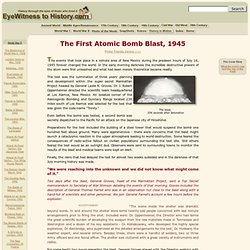
In the early morning darkness the incredible destructive powers of the atom were first unleashed and what had been merely theoretical became reality. The test was the culmination of three years' planning and development within the super secret Manhattan Project headed by General Leslie R. Groves. Dr. Rudolf Diesel. Rudolf Diesel AKA Rudolf Christian Karl Diesel Born: 18-Mar-1858Birthplace: Paris, FranceDied: 30-Sep-1913Location of death: English ChannelCause of death: SuicideRemains: Missing, lost at sea Gender: MaleRace or Ethnicity: WhiteSexual orientation: StraightOccupation: Inventor, Engineer Nationality: GermanyExecutive summary: Inventor of the diesel engine German engineer Rudolf Diesel invented the pressure-ignited heat engine, adapting the internal combustion engine so that a spark is no longer needed to ignite the fuel-air mixture.
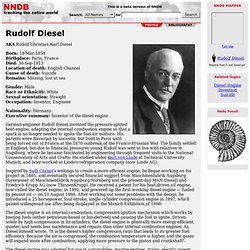
Inspired by Sadi Carnot's writings to create a more efficient engine, he began working on his project in 1885, and eventually secured financial support from Maschinenfabrik Augsburg (forerunner of Maschinenfabrik Augsburg-Nürnberg and the present-day MAN Diesel) and Friedrich Krupp AG (now ThyssenKrupp). While crossing the English Channel on the steamer Dresden on 29 September 1913, Diesel vanished.
Do you know something we don't? Samuel Morse Invents the Electric Telegraph. The Old Lawnmower Club. The First Mowers The lawn mower was invented in 1830 by Edwin Beard Budding, an engineer from Stroud, Gloucestershire, England.
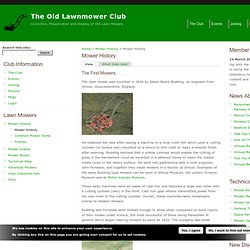
He obtained the idea after seeing a machine in a local cloth mill which used a cutting cylinder (or bladed reel) mounted on a bench to trim cloth to make a smooth finish after weaving. Budding realised that a similar concept would enable the cutting of grass if the mechanism could be mounted in a wheeled frame to make the blades rotate close to the lawn's surface. He went into partnership with a local engineer, John Ferrabee, and together they made mowers in a factory at Stroud. Examples of the early Budding type mowers can be seen in Stroud Museum, the London Science Museum and at Milton Keynes Museum. These early machines were all made of cast iron and featured a large rear roller with a cutting cylinder (reel) in the front. By the 1850s, Budding's early patents had lapsed and other companies were able to introduce their own machines. Innovation Success.
Joseph Niepce - Camera. As of July 1, 2013 ThinkQuest has been discontinued.

We would like to thank everyone for being a part of the ThinkQuest global community: Students - For your limitless creativity and innovation, which inspires us all. Teachers - For your passion in guiding students on their quest. Partners - For your unwavering support and evangelism. The Cotton Gin - Eli Whitney. John Fitch (inventor) John Fitch John Fitch (January 21, 1743 – July 2, 1798) was an American inventor, clockmaker, entrepreneur and engineer.
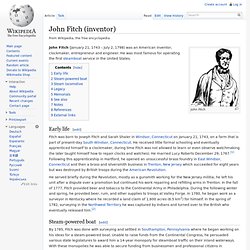
He was most famous for operating the first steamboat service in the United States. Fitch was born to Joseph Fitch and Sarah Shaler in Windsor, Connecticut on January 21, 1743, on a farm that is part of present-day South Windsor, Connecticut. He received little formal schooling and eventually apprenticed himself to a clockmaker, during time Fitch was not allowed to learn or even observe watchmaking (he later taught himself how to repair clocks and watches).
He married Lucy Roberts December 29, 1767.[1] Following this apprenticeship in Hartford, he opened an unsuccessful brass foundry in East Windsor, Connecticut and then a brass and silversmith business in Trenton, New Jersey which succeeded for eight years but was destroyed by British troops during the American Revolution. "Plan of Mr. Steamboat of April 1790 used for passenger service Other remembrances include: Thomas Savery - Invented the Steam Engine. A History of the Growth of the Steam Engine Extracts from:A History of the Growth of the Steam EngineRobert H.
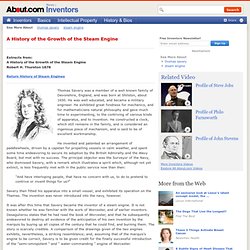
Thurston 1878 Return History of Steam Engines Thomas Savery was a member of a well known family of Devonshire, England, and was born at Shilston, about 1650. He was well educated, and became a military engineer. He invented and patented an arrangement of paddlewheels, driven by a capstan for propelling vessels in calm weather, and spent some time endeavoring to secure its adoption by the British Admiralty and the Wavy Board, but met with no success.
"And have interloping people, that have no concern with us, to do to pretend to contrive or invent things for us? " Savery then fitted his apparatus into a small vessel, and exhibited its operation on the Thames. It was after this time that Savery became the inventor of a steam engine. The most important advance in actual construction, therefore, was made by Thomas Savery. "Mr. The consumption of fuel with these engines was very great. The Agricultural Revolution. The Census of 1920 shows that hardly thirty per cent of the people are today engaged in agriculture, the basic industry of the United States, as compared with perhaps ninety per cent when the nation began.

Yet American farmers, though constantly diminishing in proportion to the whole population, have always been, and still are, able to feed themselves and all their fellow Americans and a large part of the outside world as well. They bring forth also not merely foodstuffs, but vast quantities of raw material for manufacture, such as cotton, wool, and hides. This immense productivity is due to the use of farm machinery on a scale seen nowhere else in the world. There is still, and always will be, a good deal of hard labor on the farm. But invention has reduced the labor and has made possible the carrying on of this vast industry by a relatively small number of hands. The American pioneers had only a sickle or a scythe with which to cut their grain. "History of the United States", vol. American Experience . Technology . The Telephone . Timeline (Interactive Version)